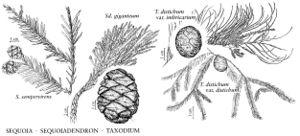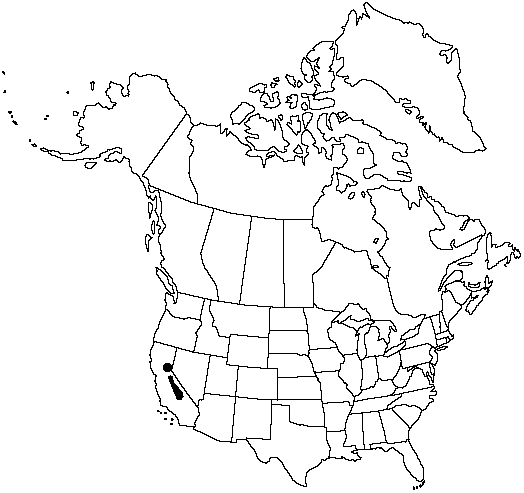Difference between revisions of "Sequoiadendron giganteum"
Amer. J. Bot. 26: 536. 1939.
FNA>Volume Importer |
GeoffLevin (talk | contribs) (Removed illegitimate name from synonymy and edited discussion to make the illegitimacy more clear.) |
||
| (8 intermediate revisions by 2 users not shown) | |||
| Line 8: | Line 8: | ||
}} | }} | ||
|common_names=Giant sequoia;bigtree;Sierra-redwood | |common_names=Giant sequoia;bigtree;Sierra-redwood | ||
| − | |basionyms={{Treatment/ID/ | + | |special_status={{Treatment/ID/Special_status |
| + | |code=F | ||
| + | |label=Illustrated | ||
| + | }}{{Treatment/ID/Special_status | ||
| + | |code=E | ||
| + | |label=Endemic | ||
| + | }} | ||
| + | |basionyms={{Treatment/ID/Basionym | ||
|name=Wellingtonia gigantea | |name=Wellingtonia gigantea | ||
|authority=Lindley | |authority=Lindley | ||
| − | + | |rank=species | |
| − | | | + | |publication_title=Gard. Chron. |
| − | | | + | |publication_place=10: 823. 1853 |
}} | }} | ||
|synonyms= | |synonyms= | ||
| Line 23: | Line 30: | ||
}}<!-- | }}<!-- | ||
| − | --><span class="statement" id="st- | + | --><span class="statement" id="st-undefined" data-properties=""><b>Trees </b>to 90 m; trunk to 11 m diam.; crown conic and monopodial when young, narrowed and somewhat rounded in age. <b>Bark</b> reddish brown, to ca. 60 cm thick, fibrous, ridged and furrowed. <b>Branches</b> generally horizontal to downward-sweeping with upturned ends. <b>Leaves</b> generally with stomates on both surfaces, the free portion to ca. 15 mm. <b>Pollen</b> cones nearly globose to ovoid, 4–8 mm. <b>Seed</b> cones 4–9 cm. <b>Seeds</b> 3–6 mm. <b>2n</b> = 22.</span><!-- |
-->{{Treatment/Body | -->{{Treatment/Body | ||
| Line 29: | Line 36: | ||
|elevation=900–2700 m | |elevation=900–2700 m | ||
|distribution=Calif. | |distribution=Calif. | ||
| − | |discussion=<p>Mature individuals of this species are the most voluminous living organisms and among the most long-lived trees. Sequoiadendron giganteum was formerly included in Sequoia, under the later homonym Sequoia gigantea (Lindley) Decaisne, a conservative placement that still has merit (J. Doyle 1945; O. Schwarz and H. Weide 1962).</p><!-- | + | |discussion=<p>Mature individuals of this species are the most voluminous living organisms and among the most long-lived trees. <i>Sequoiadendron giganteum</i> was formerly included in <i>Sequoia</i>, under the later homonym <i>Sequoia</i> gigantea (Lindley) Decaisne (1854, not Endlicher 1847), a conservative placement that still has merit (J. Doyle 1945; O. Schwarz and H. Weide 1962).</p><!-- |
| − | --><p>Redwood, including Sequoiadendron giganteum and Sequoia sempervirens, is the state tree of California.</p> | + | --><p>Redwood, including <i>Sequoiadendron giganteum</i> and <i>Sequoia sempervirens</i>, is the state tree of California.</p> |
|tables= | |tables= | ||
|references= | |references= | ||
| Line 39: | Line 46: | ||
-->{{#Taxon: | -->{{#Taxon: | ||
name=Sequoiadendron giganteum | name=Sequoiadendron giganteum | ||
| − | |||
|authority=(Lindley) J. Buchholz | |authority=(Lindley) J. Buchholz | ||
|rank=species | |rank=species | ||
|parent rank=genus | |parent rank=genus | ||
|synonyms= | |synonyms= | ||
| − | |basionyms=Wellingtonia | + | |basionyms=Wellingtonia gigantea |
|family=Cupressaceae | |family=Cupressaceae | ||
|habitat=Mixed montane coniferous forests, in isolated groves on the w slopes of the Sierra Nevada | |habitat=Mixed montane coniferous forests, in isolated groves on the w slopes of the Sierra Nevada | ||
| Line 52: | Line 58: | ||
|publication title=Amer. J. Bot. | |publication title=Amer. J. Bot. | ||
|publication year=1939 | |publication year=1939 | ||
| − | |special status= | + | |special status=Illustrated;Endemic |
| − | |source xml=https:// | + | |source xml=https://bitbucket.org/aafc-mbb/fna-data-curation/src/2e0870ddd59836b60bcf96646a41e87ea5a5943a/coarse_grained_fna_xml/V2/V2_491.xml |
|genus=Sequoiadendron | |genus=Sequoiadendron | ||
|species=Sequoiadendron giganteum | |species=Sequoiadendron giganteum | ||
| − | |||
| − | |||
| − | |||
| − | |||
| − | |||
| − | |||
| − | |||
| − | |||
| − | |||
| − | |||
| − | |||
| − | |||
| − | |||
| − | |||
| − | |||
| − | |||
| − | |||
| − | |||
| − | |||
}}<!-- | }}<!-- | ||
-->[[Category:Treatment]][[Category:Sequoiadendron]] | -->[[Category:Treatment]][[Category:Sequoiadendron]] | ||
Latest revision as of 20:48, 14 December 2022
Trees to 90 m; trunk to 11 m diam.; crown conic and monopodial when young, narrowed and somewhat rounded in age. Bark reddish brown, to ca. 60 cm thick, fibrous, ridged and furrowed. Branches generally horizontal to downward-sweeping with upturned ends. Leaves generally with stomates on both surfaces, the free portion to ca. 15 mm. Pollen cones nearly globose to ovoid, 4–8 mm. Seed cones 4–9 cm. Seeds 3–6 mm. 2n = 22.
Habitat: Mixed montane coniferous forests, in isolated groves on the w slopes of the Sierra Nevada
Elevation: 900–2700 m
Discussion
Mature individuals of this species are the most voluminous living organisms and among the most long-lived trees. Sequoiadendron giganteum was formerly included in Sequoia, under the later homonym Sequoia gigantea (Lindley) Decaisne (1854, not Endlicher 1847), a conservative placement that still has merit (J. Doyle 1945; O. Schwarz and H. Weide 1962).
Redwood, including Sequoiadendron giganteum and Sequoia sempervirens, is the state tree of California.
Selected References
None.

